Key factors influencing tree planting decisions of households: A case study in Hoa Binh province
In coping with significant deforestation and forest degradation, currently in Kim Boi district, Hoa Binh province, and massive reforestation projects have been implemented. However, when remarkable attempts and investments have been made in reforestation, interaction of household characteristics and socio-Economic factors with smallscale tree planting decision are still little understood. In this study, we survey 150 households (including 75 households with tree planting and 75 households without tree-planting) in Nuong Dam commune, Kim Boi district, Hoa Binh province. The results of stepwise binary logistic regression analysis indicate that the factors, including: Accessibility to Plantation Sites, Forestland Area, Investment Capital, and Knowledge on Silviculture have a significant effect on household’s decision on tree planting in the study area. The study results may provide the basis for proposing solutions to strengthen tree planting of households in the study area
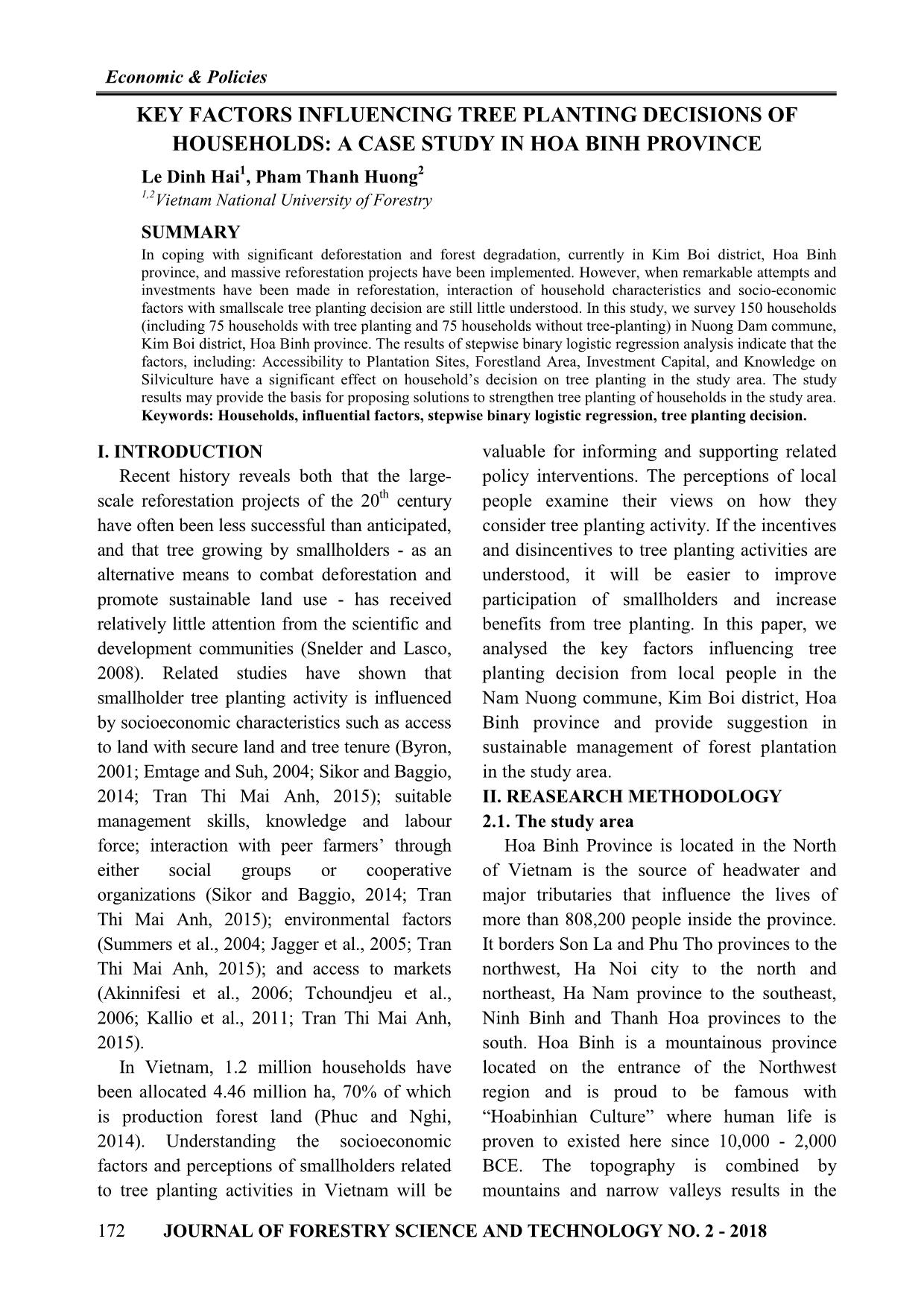
Trang 1
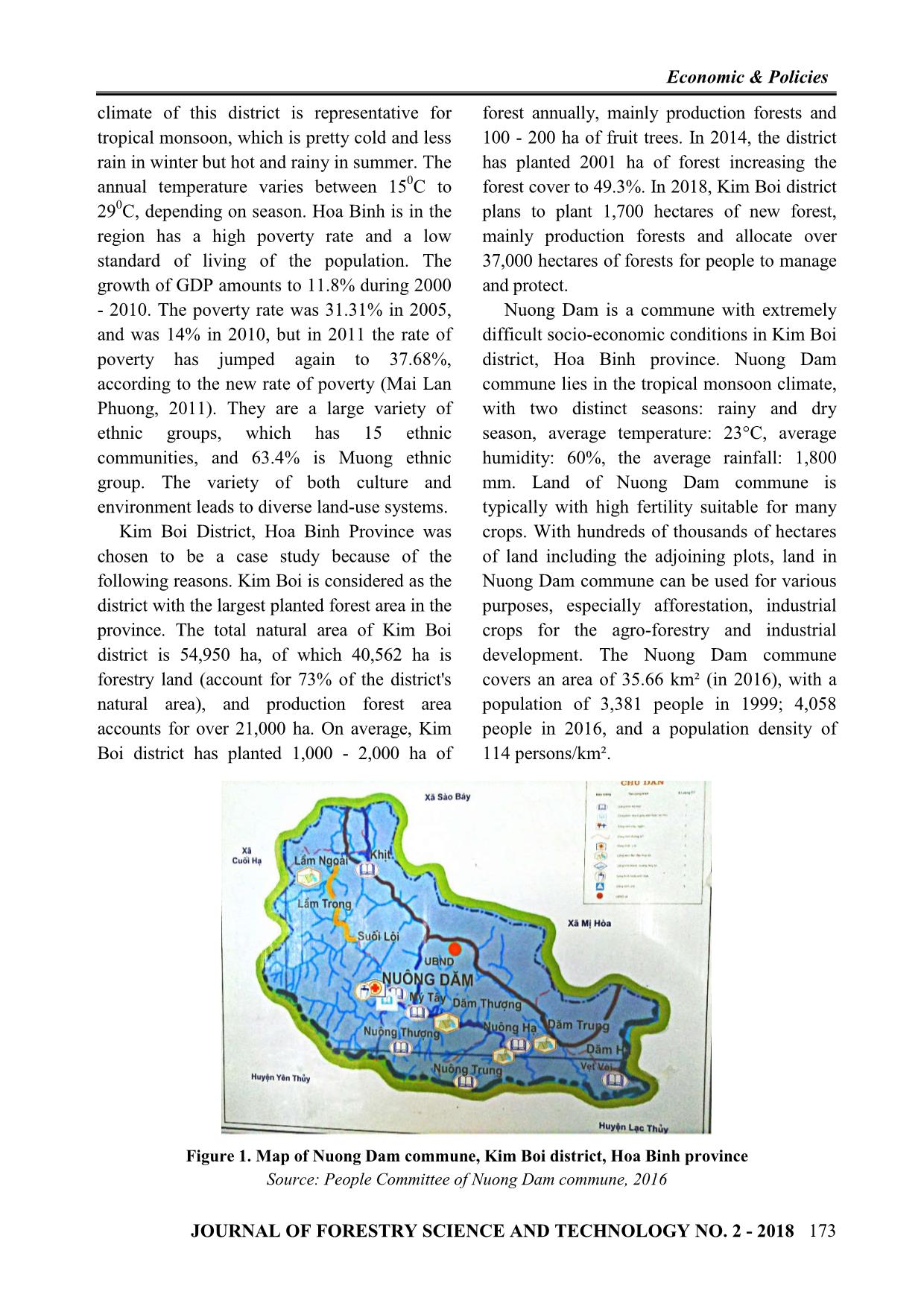
Trang 2
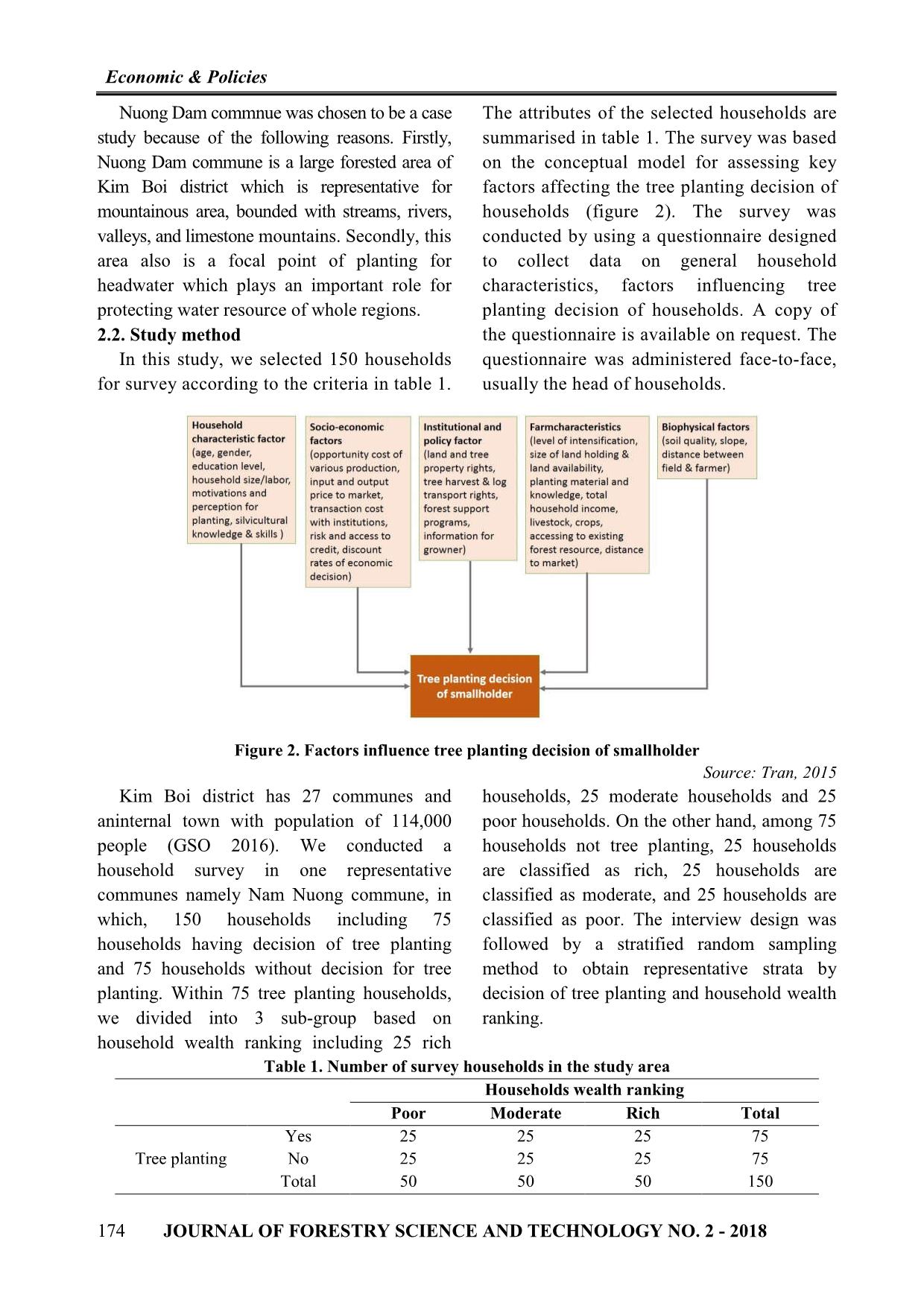
Trang 3
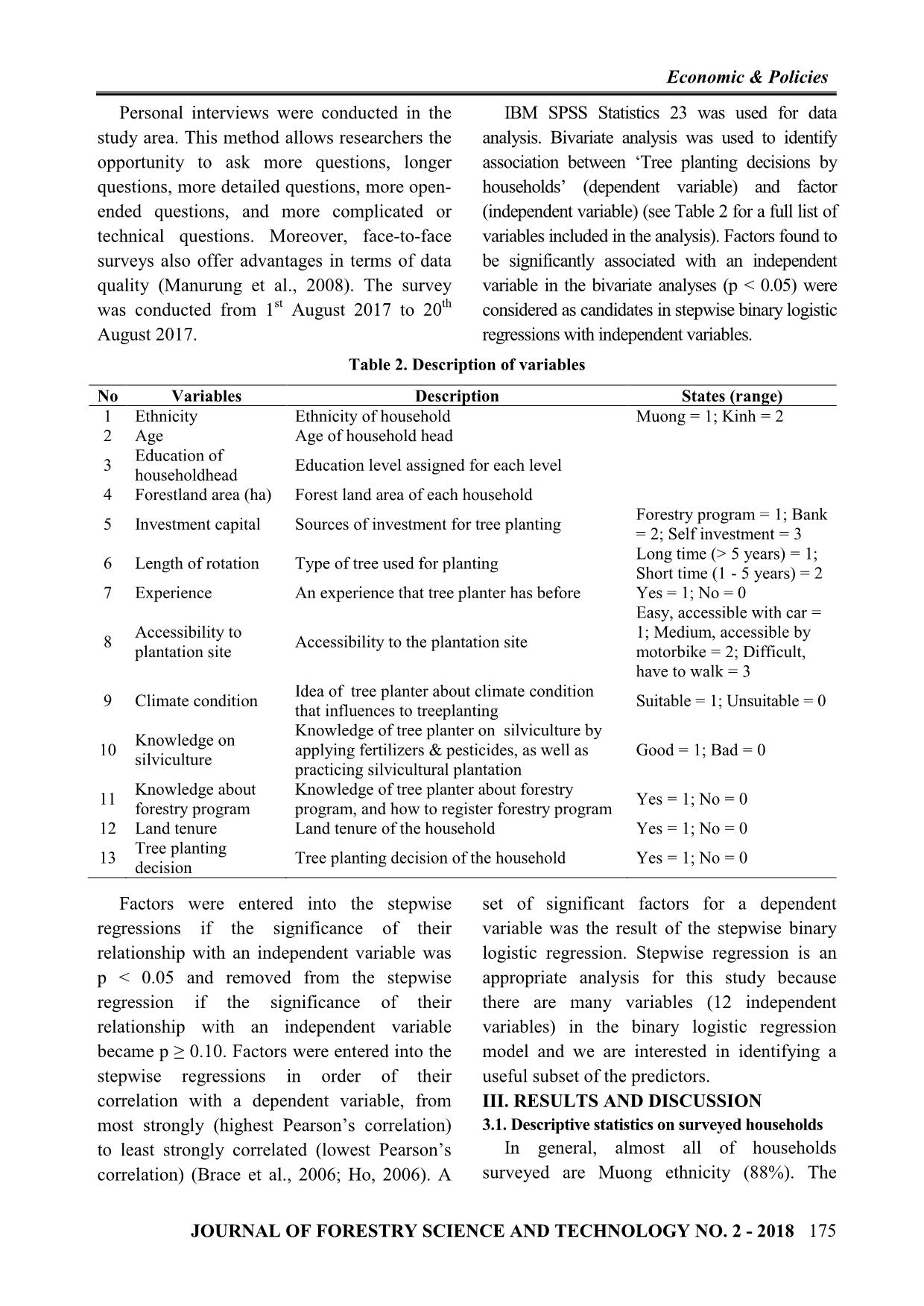
Trang 4
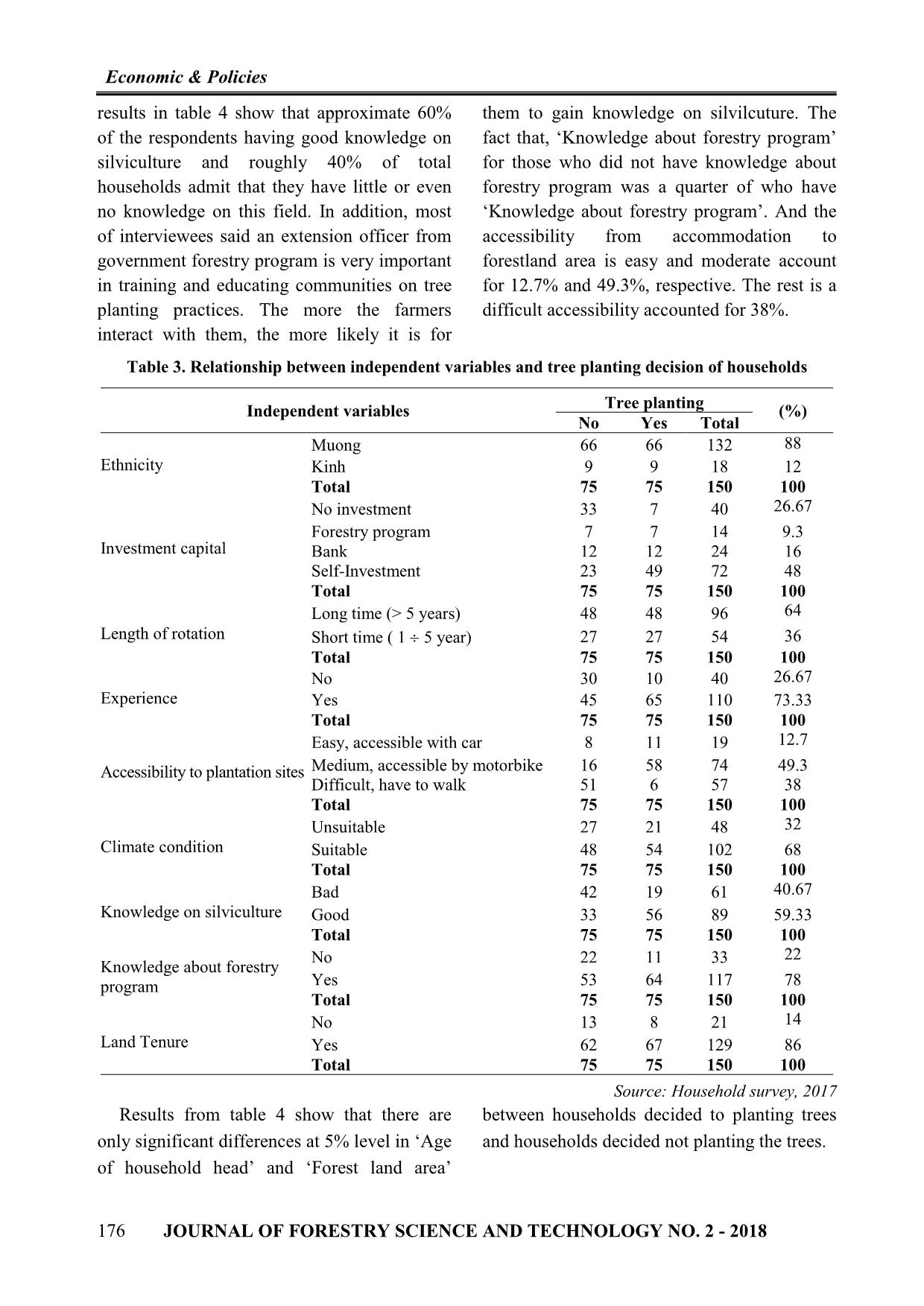
Trang 5
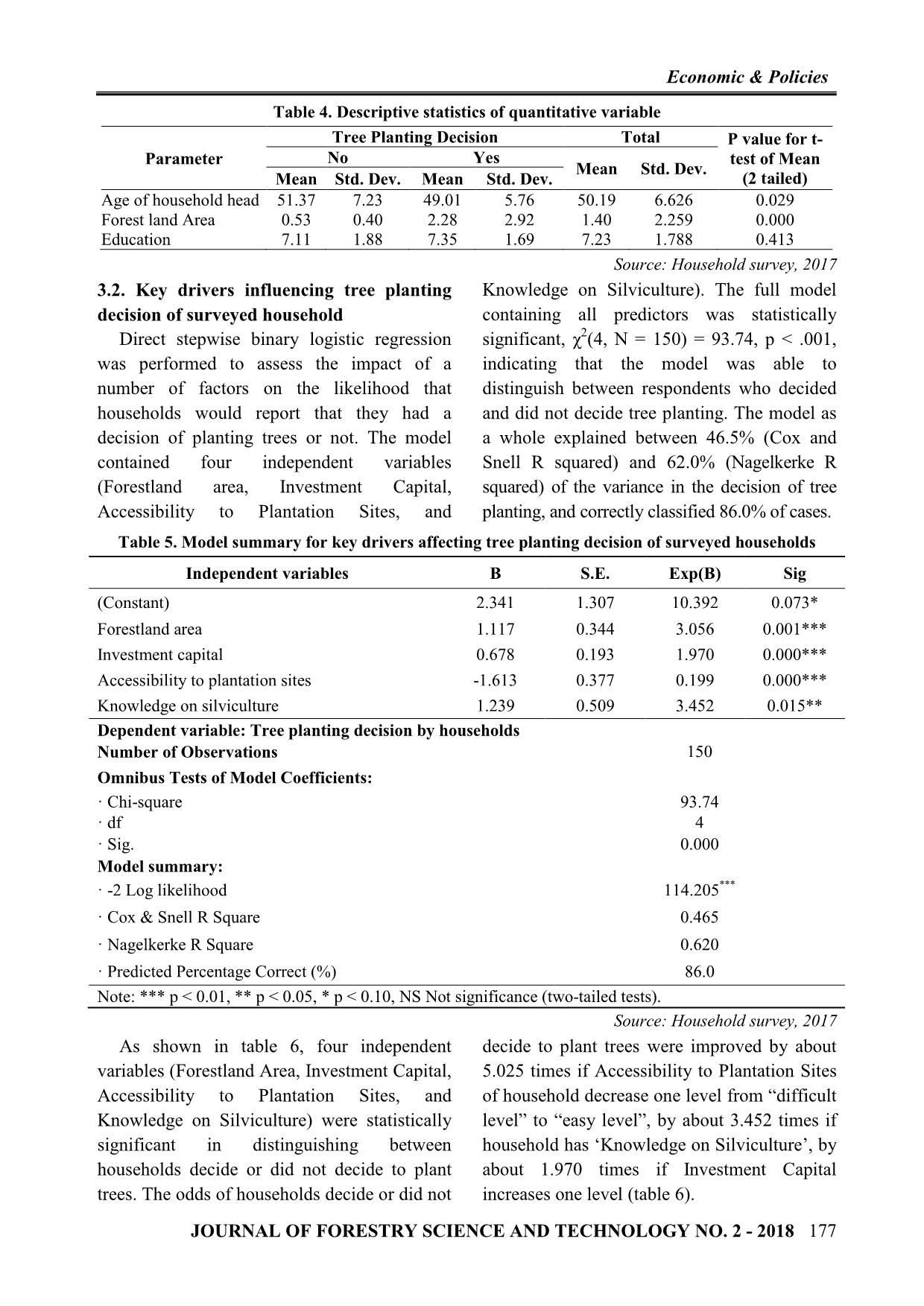
Trang 6
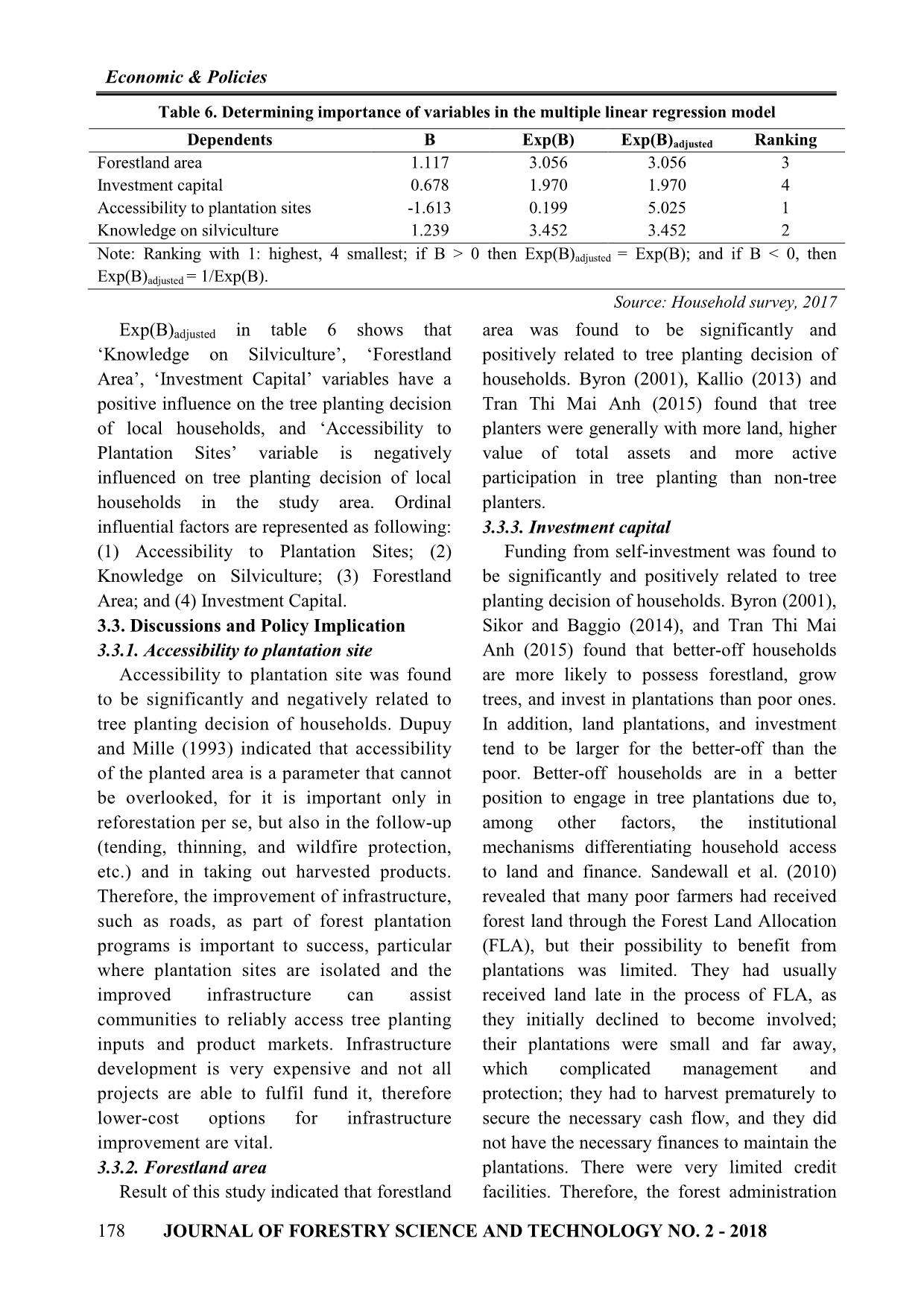
Trang 7
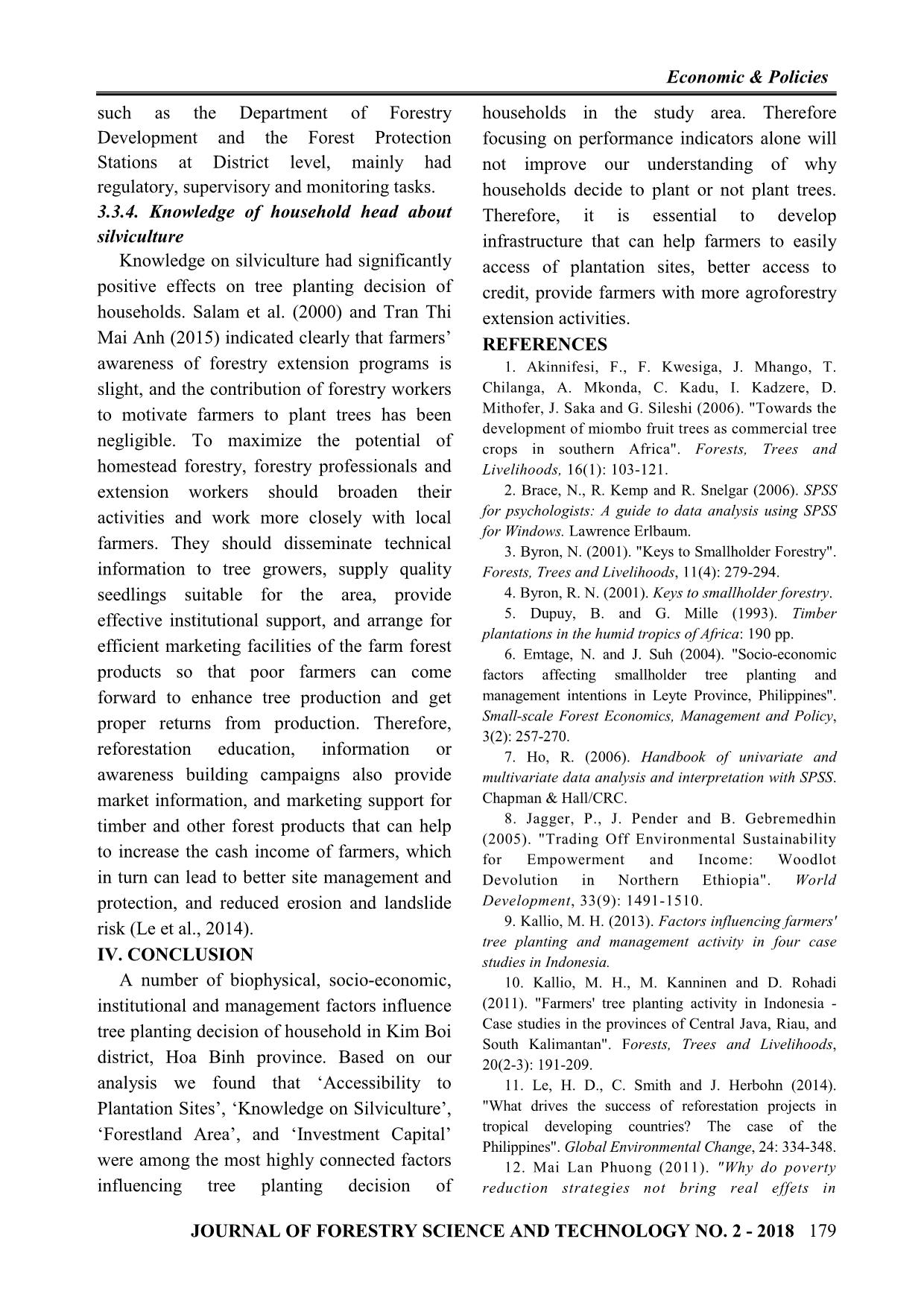
Trang 8
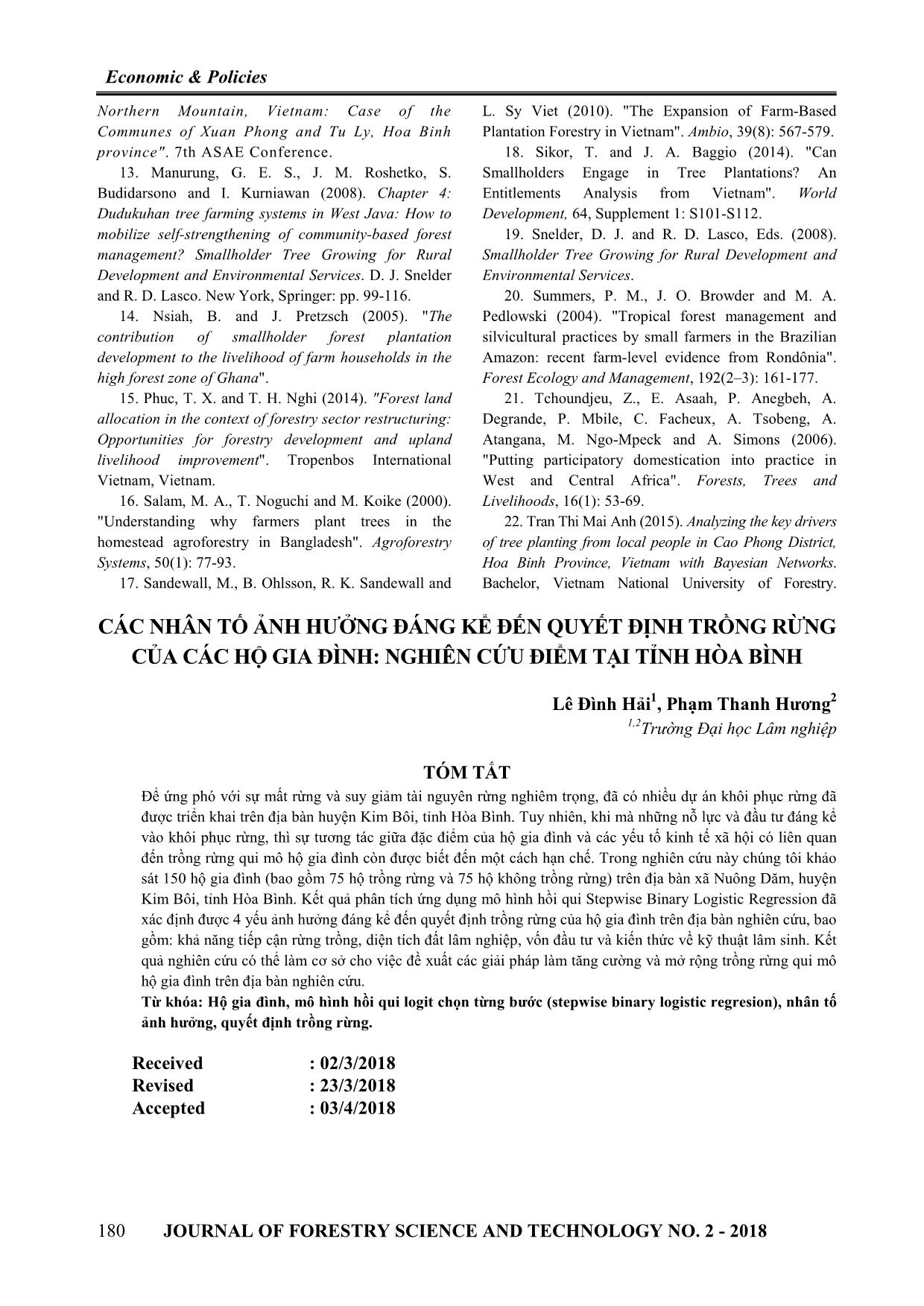
Trang 9
Tóm tắt nội dung tài liệu: Key factors influencing tree planting decisions of households: A case study in Hoa Binh province
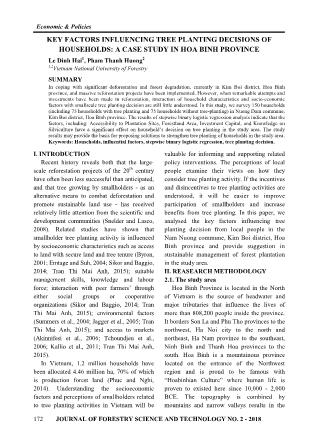
gram Yes 53 64 117 78 Total 75 75 150 100 No 13 8 21 14 Land Tenure Yes 62 67 129 86 Total 75 75 150 100 Source: Household survey, 2017 Results from table 4 show that there are between households decided to planting trees only significant differences at 5% level in ‘Age and households decided not planting the trees. of household head’ and ‘Forest land area’ 176 JOURNAL OF FORESTRY SCIENCE AND TECHNOLOGY NO. 2 - 2018 Economic & Policies Table 4. Descriptive statistics of quantitative variable Tree Planting Decision Total P value for t- Parameter No Yes test of Mean Mean Std. Dev. Mean Std. Dev. Mean Std. Dev. (2 tailed) Age of household head 51.37 7.23 49.01 5.76 50.19 6.626 0.029 Forest land Area 0.53 0.40 2.28 2.92 1.40 2.259 0.000 Education 7.11 1.88 7.35 1.69 7.23 1.788 0.413 Source: Household survey, 2017 3.2. Key drivers influencing tree planting Knowledge on Silviculture). The full model decision of surveyed household containing all predictors was statistically Direct stepwise binary logistic regression significant, χ2(4, N = 150) = 93.74, p < .001, was performed to assess the impact of a indicating that the model was able to number of factors on the likelihood that distinguish between respondents who decided households would report that they had a and did not decide tree planting. The model as decision of planting trees or not. The model a whole explained between 46.5% (Cox and contained four independent variables Snell R squared) and 62.0% (Nagelkerke R (Forestland area, Investment Capital, squared) of the variance in the decision of tree Accessibility to Plantation Sites, and planting, and correctly classified 86.0% of cases. Table 5. Model summary for key drivers affecting tree planting decision of surveyed households Independent variables B S.E. Exp(B) Sig (Constant) 2.341 1.307 10.392 0.073* Forestland area 1.117 0.344 3.056 0.001*** Investment capital 0.678 0.193 1.970 0.000*** Accessibility to plantation sites -1.613 0.377 0.199 0.000*** Knowledge on silviculture 1.239 0.509 3.452 0.015** Dependent variable: Tree planting decision by households Number of Observations 150 Omnibus Tests of Model Coefficients: · Chi-square 93.74 · df 4 · Sig. 0.000 Model summary: · -2 Log likelihood 114.205*** · Cox & Snell R Square 0.465 · Nagelkerke R Square 0.620 · Predicted Percentage Correct (%) 86.0 Note: *** p < 0.01, ** p < 0.05, * p < 0.10, NS Not significance (two-tailed tests). Source: Household survey, 2017 As shown in table 6, four independent decide to plant trees were improved by about variables (Forestland Area, Investment Capital, 5.025 times if Accessibility to Plantation Sites Accessibility to Plantation Sites, and of household decrease one level from “difficult Knowledge on Silviculture) were statistically level” to “easy level”, by about 3.452 times if significant in distinguishing between household has ‘Knowledge on Silviculture’, by households decide or did not decide to plant about 1.970 times if Investment Capital trees. The odds of households decide or did not increases one level (table 6). JOURNAL OF FORESTRY SCIENCE AND TECHNOLOGY NO. 2 - 2018 177 Economic & Policies Table 6. Determining importance of variables in the multiple linear regression model Dependents B Exp(B) Exp(B)adjusted Ranking Forestland area 1.117 3.056 3.056 3 Investment capital 0.678 1.970 1.970 4 Accessibility to plantation sites -1.613 0.199 5.025 1 Knowledge on silviculture 1.239 3.452 3.452 2 Note: Ranking with 1: highest, 4 smallest; if B > 0 then Exp(B)adjusted = Exp(B); and if B < 0, then Exp(B)adjusted = 1/Exp(B). Source: Household survey, 2017 Exp(B)adjusted in table 6 shows that area was found to be significantly and ‘Knowledge on Silviculture’, ‘Forestland positively related to tree planting decision of Area’, ‘Investment Capital’ variables have a households. Byron (2001), Kallio (2013) and positive influence on the tree planting decision Tran Thi Mai Anh (2015) found that tree of local households, and ‘Accessibility to planters were generally with more land, higher Plantation Sites’ variable is negatively value of total assets and more active influenced on tree planting decision of local participation in tree planting than non-tree households in the study area. Ordinal planters. influential factors are represented as following: 3.3.3. Investment capital (1) Accessibility to Plantation Sites; (2) Funding from self-investment was found to Knowledge on Silviculture; (3) Forestland be significantly and positively related to tree Area; and (4) Investment Capital. planting decision of households. Byron (2001), 3.3. Discussions and Policy Implication Sikor and Baggio (2014), and Tran Thi Mai 3.3.1. Accessibility to plantation site Anh (2015) found that better-off households Accessibility to plantation site was found are more likely to possess forestland, grow to be significantly and negatively related to trees, and invest in plantations than poor ones. tree planting decision of households. Dupuy In addition, land plantations, and investment and Mille (1993) indicated that accessibility tend to be larger for the better-off than the of the planted area is a parameter that cannot poor. Better-off households are in a better be overlooked, for it is important only in position to engage in tree plantations due to, reforestation per se, but also in the follow-up among other factors, the institutional (tending, thinning, and wildfire protection, mechanisms differentiating household access etc.) and in taking out harvested products. to land and finance. Sandewall et al. (2010) Therefore, the improvement of infrastructure, revealed that many poor farmers had received such as roads, as part of forest plantation forest land through the Forest Land Allocation programs is important to success, particular (FLA), but their possibility to benefit from where plantation sites are isolated and the plantations was limited. They had usually improved infrastructure can assist received land late in the process of FLA, as communities to reliably access tree planting they initially declined to become involved; inputs and product markets. Infrastructure their plantations were small and far away, development is very expensive and not all which complicated management and projects are able to fulfil fund it, therefore protection; they had to harvest prematurely to lower-cost options for infrastructure secure the necessary cash flow, and they did improvement are vital. not have the necessary finances to maintain the 3.3.2. Forestland area plantations. There were very limited credit Result of this study indicated that forestland facilities. Therefore, the forest administration 178 JOURNAL OF FORESTRY SCIENCE AND TECHNOLOGY NO. 2 - 2018 Economic & Policies such as the Department of Forestry households in the study area. Therefore Development and the Forest Protection focusing on performance indicators alone will Stations at District level, mainly had not improve our understanding of why regulatory, supervisory and monitoring tasks. households decide to plant or not plant trees. 3.3.4. Knowledge of household head about Therefore, it is essential to develop silviculture infrastructure that can help farmers to easily Knowledge on silviculture had significantly access of plantation sites, better access to positive effects on tree planting decision of credit, provide farmers with more agroforestry households. Salam et al. (2000) and Tran Thi extension activities. Mai Anh (2015) indicated clearly that farmers’ REFERENCES awareness of forestry extension programs is 1. Akinnifesi, F., F. Kwesiga, J. Mhango, T. slight, and the contribution of forestry workers Chilanga, A. Mkonda, C. Kadu, I. Kadzere, D. to motivate farmers to plant trees has been Mithofer, J. Saka and G. Sileshi (2006). "Towards the development of miombo fruit trees as commercial tree negligible. To maximize the potential of crops in southern Africa". Forests, Trees and homestead forestry, forestry professionals and Livelihoods, 16(1): 103-121. extension workers should broaden their 2. Brace, N., R. Kemp and R. Snelgar (2006). SPSS activities and work more closely with local for psychologists: A guide to data analysis using SPSS for Windows. Lawrence Erlbaum. farmers. They should disseminate technical 3. Byron, N. (2001). "Keys to Smallholder Forestry". information to tree growers, supply quality Forests, Trees and Livelihoods, 11(4): 279-294. seedlings suitable for the area, provide 4. Byron, R. N. (2001). Keys to smallholder forestry. effective institutional support, and arrange for 5. Dupuy, B. and G. Mille (1993). Timber plantations in the humid tropics of Africa: 190 pp. efficient marketing facilities of the farm forest 6. Emtage, N. and J. Suh (2004). "Socio-economic products so that poor farmers can come factors affecting smallholder tree planting and forward to enhance tree production and get management intentions in Leyte Province, Philippines". proper returns from production. Therefore, Small-scale Forest Economics, Management and Policy, 3(2): 257-270. reforestation education, information or 7. Ho, R. (2006). Handbook of univariate and awareness building campaigns also provide multivariate data analysis and interpretation with SPSS. market information, and marketing support for Chapman & Hall/CRC. timber and other forest products that can help 8. Jagger, P., J. Pender and B. Gebremedhin (2005). "Trading Off Environmental Sustainability to increase the cash income of farmers, which for Empowerment and Income: Woodlot in turn can lead to better site management and Devolution in Northern Ethiopia". World protection, and reduced erosion and landslide Development, 33(9): 1491-1510. risk (Le et al., 2014). 9. Kallio, M. H. (2013). Factors influencing farmers' tree planting and management activity in four case IV. CONCLUSION studies in Indonesia. A number of biophysical, socio-economic, 10. Kallio, M. H., M. Kanninen and D. Rohadi institutional and management factors influence (2011). "Farmers' tree planting activity in Indonesia - tree planting decision of household in Kim Boi Case studies in the provinces of Central Java, Riau, and South Kalimantan". Forests, Trees and Livelihoods, district, Hoa Binh province. Based on our 20(2-3): 191-209. analysis we found that ‘Accessibility to 11. Le, H. D., C. Smith and J. Herbohn (2014). Plantation Sites’, ‘Knowledge on Silviculture’, "What drives the success of reforestation projects in ‘Forestland Area’, and ‘Investment Capital’ tropical developing countries? The case of the Philippines". Global Environmental Change, 24: 334-348. were among the most highly connected factors 12. Mai Lan Phuong (2011). "Why do poverty influencing tree planting decision of reduction strategies not bring real effets in JOURNAL OF FORESTRY SCIENCE AND TECHNOLOGY NO. 2 - 2018 179 Economic & Policies Northern Mountain, Vietnam: Case of the L. Sy Viet (2010). "The Expansion of Farm-Based Communes of Xuan Phong and Tu Ly, Hoa Binh Plantation Forestry in Vietnam". Ambio, 39(8): 567-579. province". 7th ASAE Conference. 18. Sikor, T. and J. A. Baggio (2014). "Can 13. Manurung, G. E. S., J. M. Roshetko, S. Smallholders Engage in Tree Plantations? An Budidarsono and I. Kurniawan (2008). Chapter 4: Entitlements Analysis from Vietnam". World Dudukuhan tree farming systems in West Java: How to Development, 64, Supplement 1: S101-S112. mobilize self-strengthening of community-based forest 19. Snelder, D. J. and R. D. Lasco, Eds. (2008). management? Smallholder Tree Growing for Rural Smallholder Tree Growing for Rural Development and Development and Environmental Services. D. J. Snelder Environmental Services. and R. D. Lasco. New York, Springer: pp. 99-116. 20. Summers, P. M., J. O. Browder and M. A. 14. Nsiah, B. and J. Pretzsch (2005). "The Pedlowski (2004). "Tropical forest management and contribution of smallholder forest plantation silvicultural practices by small farmers in the Brazilian development to the livelihood of farm households in the Amazon: recent farm-level evidence from Rondônia". high forest zone of Ghana". Forest Ecology and Management, 192(2–3): 161-177. 15. Phuc, T. X. and T. H. Nghi (2014). "Forest land 21. Tchoundjeu, Z., E. Asaah, P. Anegbeh, A. allocation in the context of forestry sector restructuring: Degrande, P. Mbile, C. Facheux, A. Tsobeng, A. Opportunities for forestry development and upland Atangana, M. Ngo-Mpeck and A. Simons (2006). livelihood improvement". Tropenbos International "Putting participatory domestication into practice in Vietnam, Vietnam. West and Central Africa". Forests, Trees and 16. Salam, M. A., T. Noguchi and M. Koike (2000). Livelihoods, 16(1): 53-69. "Understanding why farmers plant trees in the 22. Tran Thi Mai Anh (2015). Analyzing the key drivers homestead agroforestry in Bangladesh". Agroforestry of tree planting from local people in Cao Phong District, Systems, 50(1): 77-93. Hoa Binh Province, Vietnam with Bayesian Networks. 17. Sandewall, M., B. Ohlsson, R. K. Sandewall and Bachelor, Vietnam National University of Forestry. CÁC NHÂN TỐ ẢNH HƯỞNG ĐÁNG KỂ ĐẾN QUYẾT ĐỊNH TRỒNG RỪNG CỦA CÁC HỘ GIA ĐÌNH: NGHIÊN CỨU ĐIỂM TẠI TỈNH HÒA BÌNH Lê Đình Hải1, Phạm Thanh Hương2 1,2Trường Đại học Lâm nghiệp TÓM TẮT Để ứng phó với sự mất rừng và suy giảm tài nguyên rừng nghiêm trọng, đã có nhiều dự án khôi phục rừng đã được triển khai trên địa bàn huyện Kim Bôi, tỉnh Hòa Bình. Tuy nhiên, khi mà những nỗ lực và đầu tư đáng kể vào khôi phục rừng, thì sự tương tác giữa đặc điểm của hộ gia đình và các yếu tố kinh tế xã hội có liên quan đến trồng rừng qui mô hộ gia đình còn được biết đến một cách hạn chế. Trong nghiên cứu này chúng tôi khảo sát 150 hộ gia đình (bao gồm 75 hộ trồng rừng và 75 hộ không trồng rừng) trên địa bàn xã Nuông Dăm, huyện Kim Bôi, tỉnh Hòa Bình. Kết quả phân tích ứng dụng mô hình hồi qui Stepwise Binary Logistic Regression đã xác định được 4 yếu ảnh hưởng đáng kể đến quyết định trồng rừng của hộ gia đình trên địa bàn nghiên cứu, bao gồm: khả năng tiếp cận rừng trồng, diện tích đất lâm nghiệp, vốn đầu tư và kiến thức về kỹ thuật lâm sinh. Kết quả nghiên cứu có thể làm cơ sở cho việc đề xuất các giải pháp làm tăng cường và mở rộng trồng rừng qui mô hộ gia đình trên địa bàn nghiên cứu. Từ khóa: Hộ gia đình, mô hình hồi qui logit chọn từng bước (stepwise binary logistic regresion), nhân tố ảnh hưởng, quyết định trồng rừng. Received : 02/3/2018 Revised : 23/3/2018 Accepted : 03/4/2018 180 JOURNAL OF FORESTRY SCIENCE AND TECHNOLOGY NO. 2 - 2018
File đính kèm:
 key_factors_influencing_tree_planting_decisions_of_household.pdf
key_factors_influencing_tree_planting_decisions_of_household.pdf

